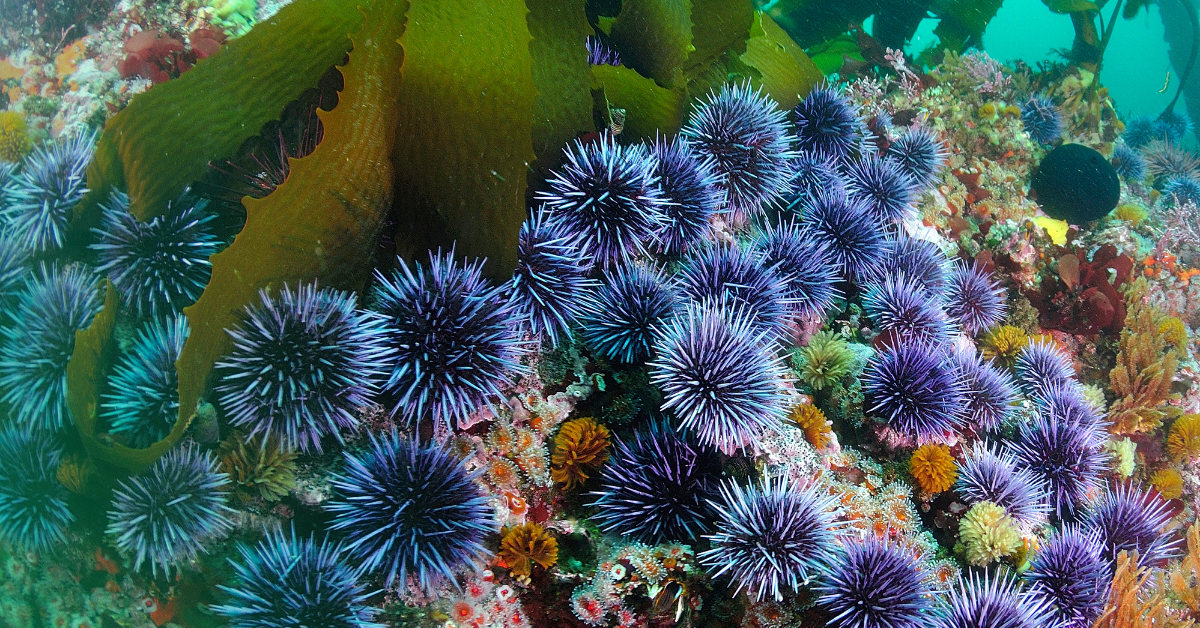
Underwater Porcupines: Made-to-Order, -Vivisect, -Destroy
The animal research industry harms other-than-human animals both by using them as stand-ins for humans, and – even more fundamentally – by perpetuating (and entrenching) the attitude that animals are constructible, tradeable, destroyable commodities.
No animals have been more exploited for this trade than those who find themselves subject to mass gene-editing – namely, mice, fruit flies, and zebrafish – and, true to the animal research industry’s inclusive, exploitation-of-all mantra, this tragic list is set to expand.1Though this piece focuses on sea urchins, the featured Los Angeles Times article also references, in passing, the genetic modification, “scientific use”, and “distribut[ion]” of clawed frogs.
An article published last week by The Los Angeles Times harkened back to our previous feature on The Jackson Laboratory and evidenced the ongoing expansion of the animal research industry’s efforts to turn life forms into made-to-order “products” for laboratory use.
The focus of these new efforts? Animals . . .
. . . from whom “humans live vastly different lives” but with whom humans “genetically are quite similar”.
. . . who have long been exploited for human food and who, for at least 150 years, have been exploited in the name of human science.
. . . who are “typically” claimed to be “non-sentient” despite evidence of “complex individual and social” behaviors and the capacity to “suffer[] pain”.
. . . who you know as “sea urchins” – or, less commonly but no less aptly, porcupines of the sea.

Sea urchins appear to be the latest, in vogue victims of the animal research industry, which is seeking to render their large-scale exploitation both practical and profitable by “set[ting] the stage for urchins to rival mice, flies as model organisms”.
Animal researchers have long exploited sea urchins, but their use has been less extensive than “more easily accessible animals: mice, fruit flies, worms” because of “practical concerns”: researchers typically had to invest effort into procuring them – i.e., “spend part of their year collecting them from the ocean” (really, kidnapping them from their homes), rather than, say, ordering them from a catalog.
Their failure to be exploited on a broader scale led vivisector-acting-as-entrepreneur Amro Hamdoun of UC San Diego’s Scripps Institution of Oceanography to start working on making it possible for researchers to “access sea urchins as easily as mice” – on making genetically-modified sea urchins available “to researchers anywhere”.
‘If you want a transgenic line [of fruit fly, zebrafish, or mouse] that labels the nervous system, you could probably get that. You could order it. And that’s what we hope we can be for sea urchins.’
Already – and with an unwavering eye toward full-on sea urchin trafficking – researchers have begun trading in urchin parts: “sending tiny vials of transgenic urchin sperm to interested scientists, who can grow bespoke urchins with eggs acquired from Hamdoun’s lab or another source.”
Transparently, the interviewed animal researchers failed to even feign any regard for the lives they are creating, manipulating, brutalizing, and ending, and from which they are excitedly profiting.

In discussing their latest foray into mass production of living beings for use as means to others’ ends, the animal researchers displayed the callousness characteristic of their chosen profession (which at times became shared by the reporting journalist). Together:
- They compared sentient beings to bread – equating the “making” of sentient “new transgenic lab animals, ‘a fruit fly from the sea[]’” with the “making [of] sourdough” loaves of bread.
- They compared sentient beings to Christmas decorations and the consequences of their violations with entertainment – likening a sea urchin made to glow (through the injection of “a fluorescent protein form a jellyfish” – “the first transgenic sea urchin”) with “a Christmas bulb under a fluorescent light”, and correlating the urchin’s resulting “[f]luorescence” with a “party trick”.
- They compared sentient beings with inanimate objects in storage – equating an “experimental aquarium” that holds sentient beings captive with “a garage-like space” that has been “crammed . . . full”.
Additional, recent coverage of sea urchin gene-editing mirrored this perverse disposition, stating that “the animals are primed to become a regular tool for scientists” with “expand[ed] utility”.
Equally tellingly, the interviewed animal researchers did not even pretend that their exploitation of other-than-human animals is good science.
As recorded for posterity in the LA Times article, a UC San Diego researcher admitted that his professional kin “tend to study mice, flies and the like not because the animals’ biology is best suited to answer their questions”. Rather, these animals are “studied” because they are broadly and easily available to researchers – and, undoubtedly, because they are not regulated (or protected) in any way by applicable law.
Already without any legal protections, sea urchins are well on their way to fitting the rest of this bill, which excites scientists – again – for reasons other than science. Says one researcher: they “can’t fly away [like fruit flies can] – in short, an ideal lab animal….”
Animal research is mass exploitation masquerading as science, something that even industry actors implicitly concede when speaking candidly. We who know this must join together and stop it – not only for the sake of the porcupines of the sea, but for the sake of us all.
Urchins are just one of many species that you may be astounded to learn are used and abused in research and testing. Discover the truth about another surprising species exploited in the name of science here.